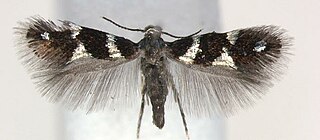
The Sesiidae or clearwing moths are a diurnal moth family in the order Lepidoptera known for their Batesian mimicry in both appearance and behaviour of various Hymenoptera.

Gelechioidea is the superfamily of moths that contains the case-bearers, twirler moths, and relatives, also simply called curved-horn moths or gelechioid moths. It is a large and poorly understood '"micromoth" superfamily, constituting one of the basal lineages of the Ditrysia.

The Batrachedridae are a small family of tiny moths. These are small, slender moths which rest with their wings wrapped tightly around their bodies.

Spilomelinae is a very species-rich subfamily of the lepidopteran family Crambidae, the crambid snout moths. With 4,135 described species in 344 genera worldwide, it is the most speciose group among pyraloids.

The Plutellidae are a family of moths commonly known as the diamondback moths, named after the diamondback moth of European origin. It was once considered to have three subfamilies: Plutellinae, Praydinae, and Scythropiinae. Praydinae was later elevated to its own family, Praydidae, while Scythropiinae has variously been moved to Yponomeutidae or also elevated to its own family.

The Heliozelidae, commonly known as shield-bearer moths, are a family of small, day flying monotrysian moths distributed worldwide. The larvae of most heliozelid species are leaf miners who cut distinctive shield-shaped cases from the surface of the host leaf, hence the common name. Some species are considered pests of commercial crops such as grapevines, cranberries, and walnuts. The taxonomy of this family is poorly understood.

Brachmia is a genus of the twirler moth family (Gelechiidae). Among these, it is mostly placed in the subfamily Dichomeridinae.

Eudonia is a large and widespread genus in the grass moth family (Crambidae), subfamily Scopariinae. There is no common name for the roughly 250 species placed here; new species are still being described regularly. Although the genus was proposed early in the 19th century, many of these moths were for a long time retained in Scoparia, the type genus of the subfamily and a close relative of Eudonia. A few small genera have been proposed for separation from Eudonia, but given the size of this group this is not particularly convincing; thus, all are retained here pending a comprehensive phylogenetic review.

Ichneutica is a genus of cutworm or dart moths in the family Noctuidae. The genus is found in New Zealand and surrounding islands. There are more than 80 described species in Ichneutica, the largest known genus of Lepidoptera in New Zealand. In 2019 this genus was revised and greatly expanded with the genera Graphania Hampson, 1905, Tmetolophota Hampson, 1905 and Dipaustica Meyrick, 1912 all subsumed within it.

Asaphodes is a genus of moths in the family Geometridae erected by Edward Meyrick in 1885. This genus is endemic to New Zealand and species within this genus are found throughout New Zealand including the North, South and Stewart / Rakiura Islands.

Erechthias is a genus of the fungus moth family, Tineidae. Therein, it belongs to the subfamily Erechthiinae, of which it is the type genus. The exact circumscription of this genus is still disputed, but it may encompass more than 150 species.

Nemapogon is a genus of the fungus moth family, Tineidae. Therein, it belongs to the subfamily Nemapogoninae. As evident by its name, it is the type genus of its subfamily.
Coniostola is a genus of moths belonging to the subfamily Olethreutinae of the family Tortricidae.
Namasia is a genus of Leafroller Moths in the moth family Tortricidae. There are at least two described species in Namasia.

Schiffermuelleria is a genus of concealer moths in the family Oecophoridae. There are more than 30 described species in Schiffermuelleria, found in Europe, Africa, Asia, and New Zealand.

Tinea is a genus of the fungus moth family, Tineidae. Therein, it belongs to the subfamily Tineinae. As evident by its name, it is the type genus of its subfamily and family. Established as one of the first subgroups of "Phalaena", it used to contain many species of Tineidae that are nowadays placed in other genera, as well as a few moths nowadays placed elsewhere.

Hypercallia is a genus of gelechioid moths.

Calicotis is a genus of moths in the family Stathmopodidae, although it is sometimes included in the family Oecophoridae. In 2024, the genus Pachyrhabda was synonymised with Calicotis.
Pronomeuta sarcopis is a moth in the family Zygaenidae. It was described by Edward Meyrick in 1905 from Sri Lanka.

Tingena is a genus of the concealer moth family (Oecophoridae). This genus is endemic to New Zealand.
















